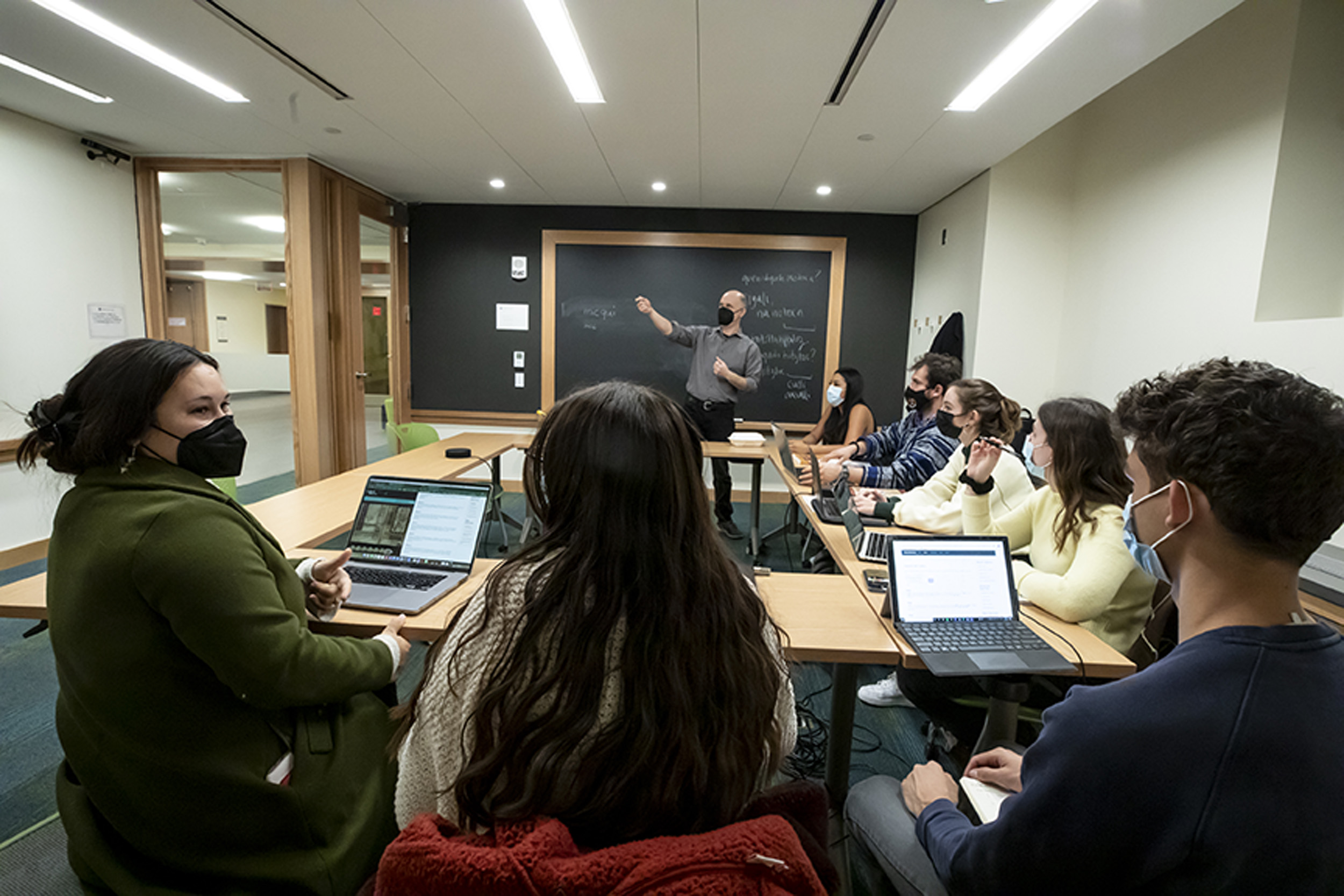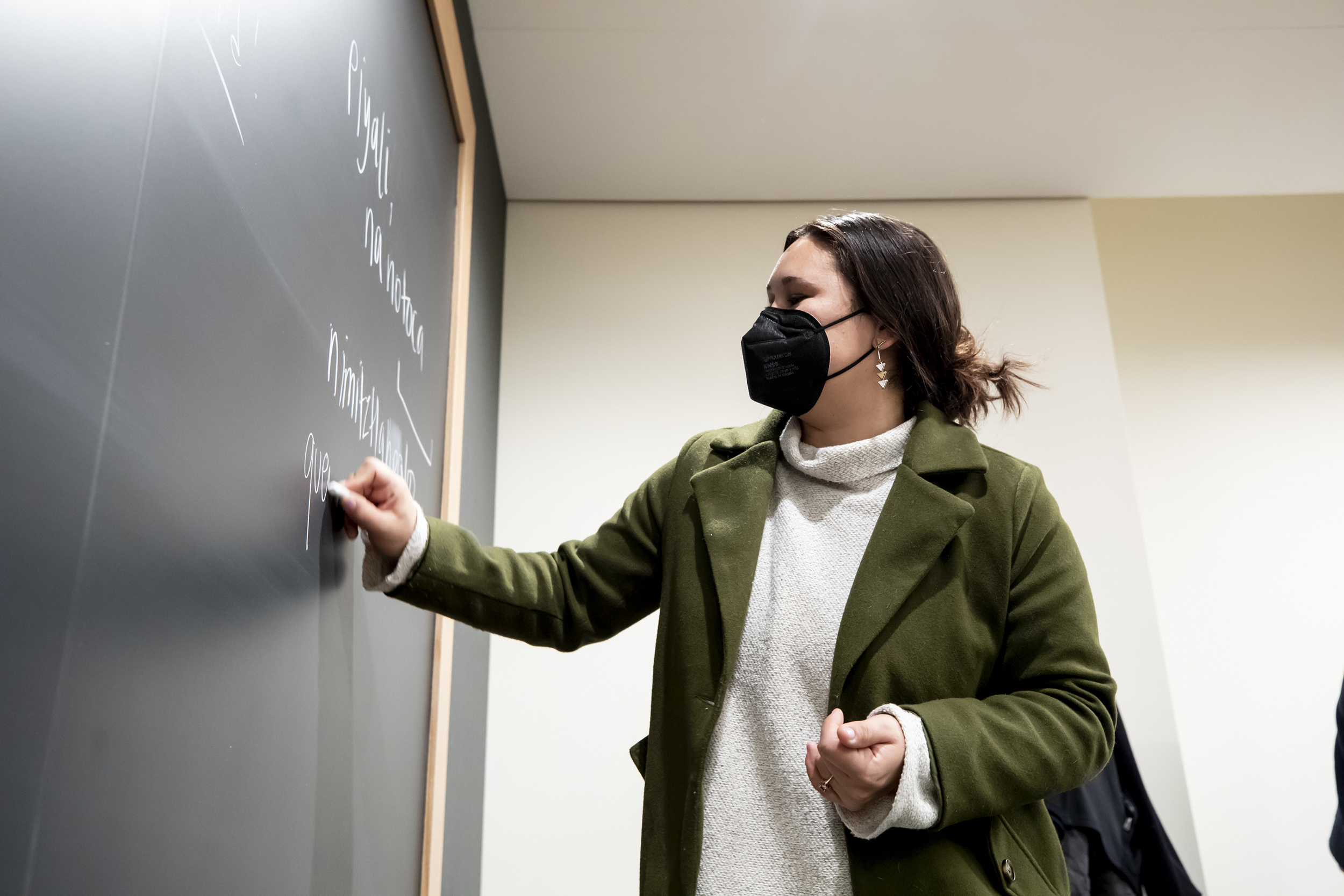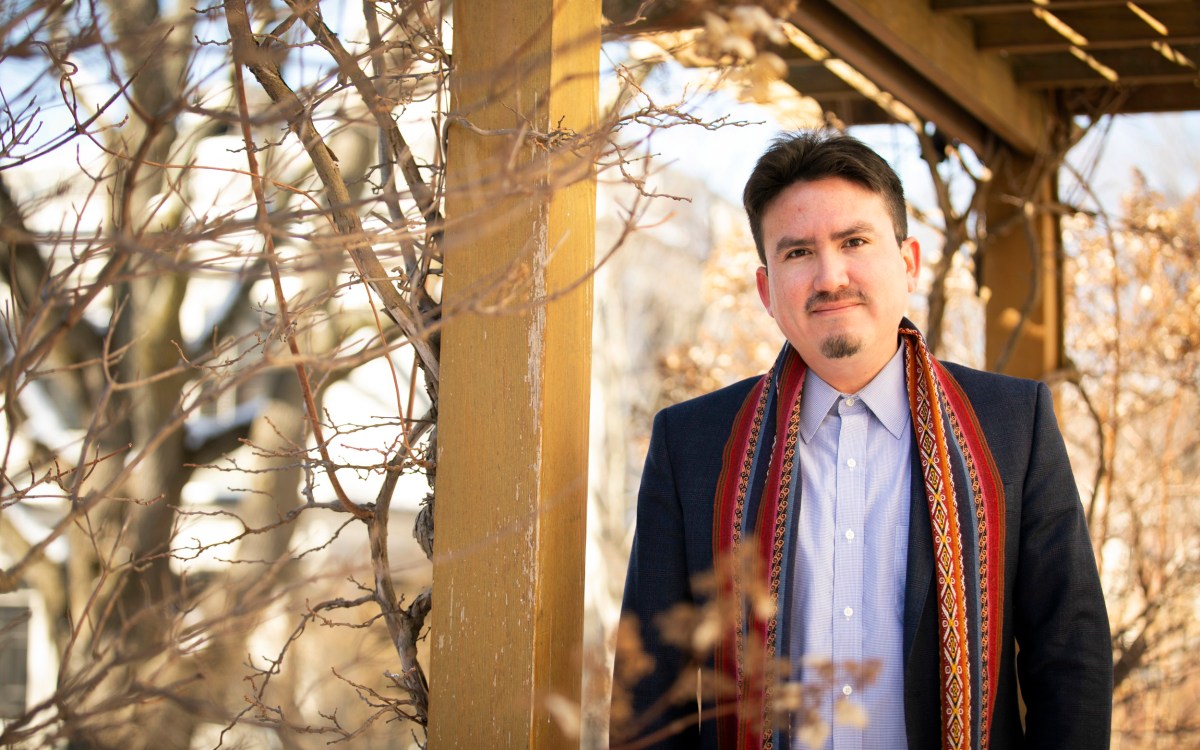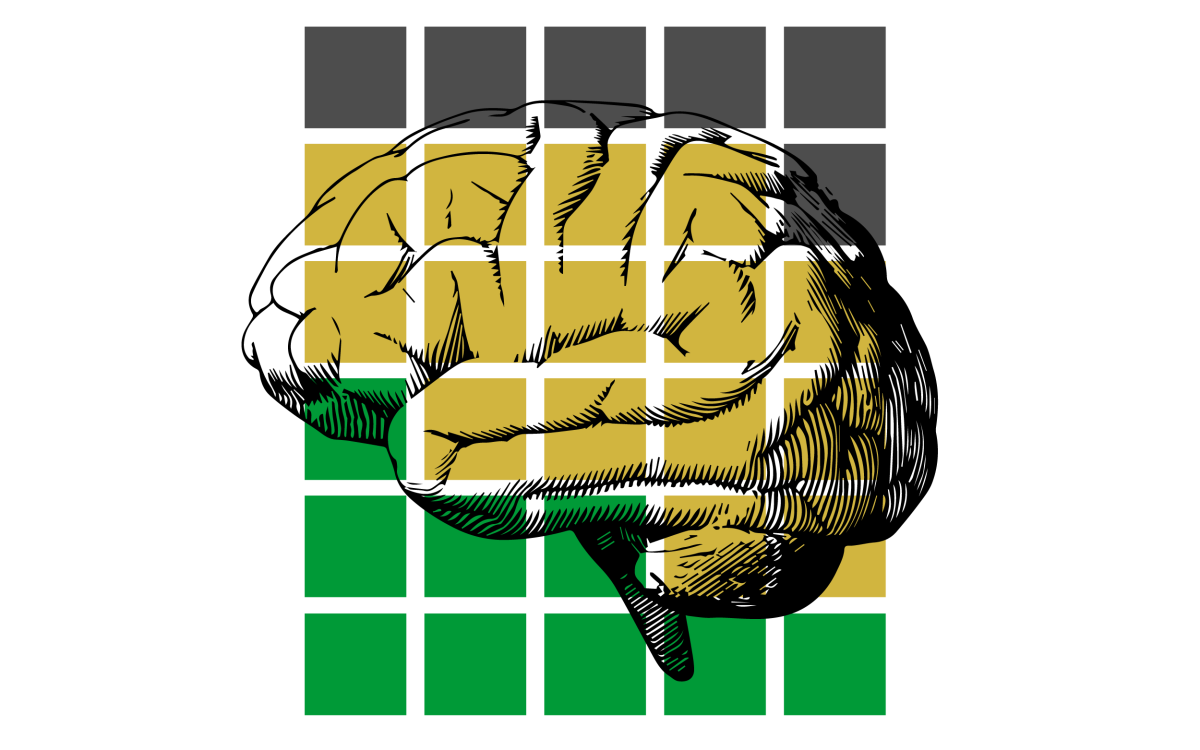
Nahuatl language study group meets at Swartz Hall under the guidance of Ben Leeming, a historian who specializes in Mesoamerican ethnohistory.
Rose Lincoln/Harvard Staff Photographer
At Div School, centuries-old Aztec language speaks to the present
History, inspiration for students in group effort to learn Nahuatl
Growing up in Los Angeles as the daughter of Mexican immigrants, Liz Contreras used English and Spanish, but she also expressed herself with Nahuatl, an Indigenous language spoken in central Mexico since the seventh century.
She just didn’t know it.
“My family is from a small pueblo in the south of Mexico,” said Contreras, a master’s student at the Harvard Graduate School of Education. “I grew up learning Spanish with Nahuatl incorporated into our Spanish here and there, except that I thought I was just learning Spanish.”
Contreras’ assumption is common. Many people are unaware of Nahuatl’s mark on both Spanish and English. Nahuatl was the lingua franca of the Aztecs, who ruled Mexico between the 14th and 16th centuries before they were conquered by the Spaniards. It is still spoken by nearly 1.5 million Mexicans, but otherwise is largely unknown. According to the J. Willard Marriott Library, the University of Utah is the only U.S. academic institution that teaches Nahuatl on a regular basis.
The English vocabulary has adopted several Nahuatl-derived words, which stand for Mexico-originated crops that have become staple foods around the world. Avocado comes from the Nahuatl word ahuakatl; chocolate from xocolatl; tomato from tomatl; and chili from cilli.
Nahuatl novice takes crack at 1576 text
Rebecca Mendoza Nunziato takes part in an informal study group to study Nahuatl, the language of the Aztecs that has been spoken in central Mexico since the seventh century. Here she uses what she’s learned so far to interpret a page in the Codex of Aubin, written by Nahuatl scribes in 1576 in mixed pictographic-alphabetic format. The page she chose is about the migration of the Mexica people to the place that would become Mexico City. The squares in the upper right represent dates while the tree represents place, in this case, “Huixachtitlan.” (Audio by Rebecca Mendoza Nunziato; image © The Trustees of the British Museum)
transcript
Transcript:
Rebecca Mendoza Nunziato: This is a page from an amoxtli or book often called a codex and this is the Codex Aubin. This codex is known for including over 400 years of the history of the Mexica or Azteca people and shows the origins and the movement to the foundation of Mexico Tenochtitlan, which is now Mexico City. This codex also provides valuable information about the early colonial period.
So I’m looking at Pages 24 and 25. And 24 is a little bit of an advanced paleography (laughs).
But on the right side you’ll see four calendar dates, which consist of a day sign and the circles, which are a number corresponding with that day sign, and together those create a date. And then there’s some Nahuatl text written above and below, and I can read those words to the best of my ability and then describe a little bit about what I think it means.
OK so on the top right you’ll see the number 8. And that reads:
(Chicueyi) tecpatl xihuitl ic onicuanique in Huixachtitlan in Mexica.
And then below where the number 11 is, it says:
(Mahtlactli huan ce) acatl xihuitl ipan nauh-xiuhtique in Huixachtitlan in Mexica.
So these two dates, which are “8 Flint” and “11 Reed” can be seen here. And I believe what this page is telling us is that there were four years that the Mexica had moved and then stayed in a place called Huixachtitlan – I don’t think I’m pronouncing that right (laughs). But I believe that this is what this page is saying and I look forward to hearing if I got that right.
In the case of Contreras, she learned that huauzontle (a vegetable similar to broccoli), tenochtl (tuna fruit), and tlacoyos (snacks) were Nahuatl words during a session of the Nahuatl Study Group, in which she took part last fall. She was joined by a dozen other Harvard students who share an interest in the language.
Nahuatl Notequixpoyohuan (“My Nahuatl Friends”) is housed at the Divinity School and supported by Davíd Carrasco and the Raphael and Fletcher Lee Moses Mesoamerican Archive and Research Project, the Harvard University Native American Program, and the David Rockefeller Center for Latin American Studies. Some students in the group, now in its second semester, want to reclaim their roots and culture. Some are researchers who need Nahuatl to use primary sources left by scribes.
On a recent evening, students gathered at Swartz Hall under the guidance of Nahuatl instructor Ben Leeming, a historian who specializes in Mesoamerican ethnohistory. After a grammar review, the group worked on interpreting a codex written by Nahuatl scribes in 1576 in mixed pictographic-alphabetic format. (Originally, Nahuatl used a script consisting of pictographs, but it adopted the Spanish alphabet after the 1521 Spanish conquest of Mexico.)
Owned by the British Museum, the Codex of Aubin is a fascinating history of the Aztec people from foundational myths to their lives during the Spanish conquest and early Spanish colonial period. The codex is especially valuable for providing a Native perspective on the past, said Leeming, who studied Nahuatl with Native speakers in Mexico.
“What is important about the codices and manuscripts Nahuatl scribes wrote is that it’s Native people themselves telling their own history,” he said.
Through the Nahuatl study group, Rebecca Mendoza Nunziato seeks “to reconnect with the wisdom and knowledge that have been lost, colonized, and erased.”
Rose Lincoln/Harvard Staff Photographer

Many Indigenous languages are endangered, and few are taught in universities. For Rebecca Mendoza Nunziato, a master’s of divinity student who hails from Colorado, the study group represents an important step in dismantling colonial narratives and an effort to reconnect with her cultural roots. Her father is of Mexican descent and her grandparents were farm workers in Texas and Colorado.
“It’s partly to honor my ancestors, and to reclaim Spanish, and something that existed before Spanish,” she said. “I also wanted to reconnect with the wisdom and knowledge that have been lost, colonized, and erased.”
Reading antique manuscripts in the original language is a thrill, said Mendoza Nunziato, who was surprised to learn from the documents the origin of the name Aztecs — that they hailed from mythical Aztlan. The Aztecs also called themselves Mexicas.
“It was an ‘aha’ moment for me,” she said. “I had been taught that they didn’t call themselves Aztecs, that that was a name that others gave them later on. It was so cool to learn from their own words what they called themselves in a primary document from 400 years ago.”
The ability to read primary sources was no less a draw for Quinn Matos, a master’s candidate in theological studies who is studying medical and ritual traditions in the Americas and the African Diaspora. Matos, who will head to NYU Long Island School of Medicine in the fall, said he’s gained from the group a greater understanding of ancient medicinal practices and a deeper appreciation of Indigenous languages — especially Nahuatl, which is made up of strung-together morphemes that tend to build long words.
“It’s a poetically gorgeous language,” said Matos, “and it sounds beautiful.”
According to Leeming, the longest word in Nahuatl comes from a Nahuatl drama titled “The Three Kings,” which was probably written in the 17th century: itlaçomahuizÇenquiscatlaçomahuizqualtilispepetlaquilisXayacatzin. The ethnohistorian and anthropologist Louise Burkhart translates it as “[his] precious, wondrous, utterly precious, wondrous, good, and shining face,” and refers to the face of baby Jesus.
“I studied Nahuatl because I became fascinated with the language,” said Leeming. “It’s beautiful, poetic, and full of metaphors.”
As for Contreras, she would like to use her Nahuatl knowledge in the classroom to help younger generations preserve a cultural heritage that is often overlooked and underappreciated.
“When we speak our Indigenous language, we are breathing life into a past that others tried to erase,” she said. “By remembering the past, we can co-create a new future that includes Indigenous languages. The future includes Indigenous peoples and language is one way to make sure we are not forgotten or forget ourselves.”







